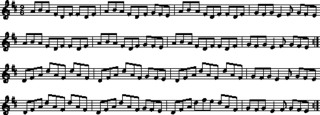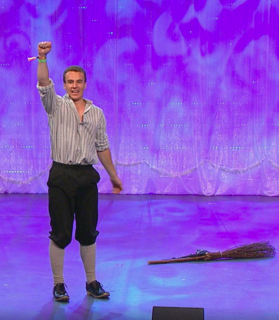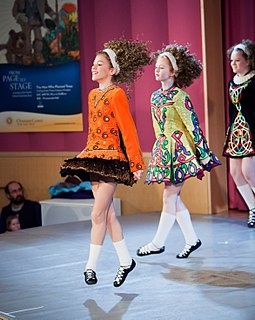The banjo is a stringed instrument with a thin membrane stretched over a frame or cavity to form a resonator. The membrane is typically circular, and usually made of plastic, or occasionally animal skin. Early forms of the instrument were fashioned by African-Americans in the United States, adapted from African instruments of similar design. The banjo is frequently associated with folk and country music, and has also been used in some rock songs. Several rock bands, such as The Eagles, Led Zeppelin, and The Allman Brothers, have used the five-string banjo in some of their songs. Historically, the banjo occupied a central place in African-American traditional music and the folk culture of rural whites before entering the mainstream via the minstrel shows of the 19th century. Along with the fiddle, the banjo is a mainstay of American styles of music, such as Bluegrass and old-time music. It is also very frequently used in traditional ("trad") jazz.

The jig is a form of lively folk dance in compound metre, as well as the accompanying dance tune. It developed in 16th-century England, and was quickly adopted on mainland Europe where it eventually became the final movement of the mature Baroque dance suite. Today it is most associated with Irish dance music, Scottish country dance and the Métis people in Canada. Jigs were originally in duple compound metre,, but have been adapted to a variety of time signatures, by which they are often classified into groups, including light jigs, slip jigs, single jigs, double jigs, and treble jigs.

Irish Dance is a group of traditional dance forms originating from Ireland, encompassing dancing both solo and in groups, and dancing for social, competitive, and performance purposes. Irish Dance in its current form developed from various influences such as Native Irish Dance, French quadrilles and English country dancing. Dance was taught by "travelling dance masters" across Ireland in the 17th-18th century, and separate dance forms developed according to regional practice and differing purposes. Irish dance became a significant part of Irish culture, particularly for Irish nationalist movements. From the early 20th century, a number of organisations promoted and codified the various forms of dance, creating competitive structures and standardised styles.

Tap dance is a type of dance characterised by using the sounds of metal taps affixed to the heel and toe of shoes striking the floor as a form of percussion, coupled with both characteristic and interpretative body movements. Its roots were in minstrel shows, it gained prominence in vaudeville, then emerged into an art form and means of expression alongside the evolution of jazz.
Bluegrass music is a genre of American roots music that developed in the 1940s in the United States Appalachian region. The genre derives its name from the band Bill Monroe and the Blue Grass Boys. Unlike mainstream country music, bluegrass is traditionally played on acoustic stringed instruments. Bluegrass has roots in traditional English, Scottish and Irish ballads and dance tunes, and in traditional African-American blues and jazz. Bluegrass was further developed by musicians who played with Monroe, including 5-string banjo player Earl Scruggs and guitarist Lester Flatt. Monroe characterized the genre as: "Scottish bagpipes and ole-time fiddlin'. It's Methodist and Holiness and Baptist. It's blues and jazz, and it has a high lonesome sound."
A solo dance is danced by an individual dancing alone, as opposed to couples dancing together but independently of others dancing at the same time, if any, and as opposed to groups of people dancing simultaneously in a coordinated manner. Solo dancers are usually the best dancers in a group or dance school. Most solo dancers start after about 6–7 years of dance or sooner. Most soloists are company kids of their dance school. They are usually in more than one dance.
Irish set dance, sometimes called "country sets", is a popular form of folk dancing in Ireland.

Step dance is a generic term for dance styles in which footwork is considered to be the most important part of the dance and limb movements and styling are either restricted or considered irrelevant.

Slip jig refers to both a style within Irish music, and the Irish dance to music in slip-jig time. The slip jig is in 9
8 time, traditionally with accents on 5 of the 9 beats — two pairs of crotchet/quaver followed by a dotted crotchet note.
Old-time music is a genre of North American folk music. It developed along with various North American folk dances, such as square dancing, clogging, and buck dancing. It is played on acoustic instruments, generally centering on a combination of fiddle and plucked string instruments, most often the banjo, guitar, and mandolin.
Clogging is a type of folk dance practiced in the United States, in which the dancer's footwear is used percussively by striking the heel, the toe, or both against a floor or each other to create audible rhythms, usually to the downbeat with the heel keeping the rhythm.

Clog dancing is a form of step dance characterised by the wearing of inflexible, wooden soled clogs. Clog dancing developed into differing intricate forms both in Wales and also in the North of England. Welsh clog dancing mainly originates from various slate mines where workers would compete against each other during work breaks. Northern English traditional clog dancing originates from Lancashire, Yorkshire, County Durham, Northumberland and the Lake District.
African-American dance has developed within Black American communities in everyday spaces, rather than in studios, schools or companies. These dances are usually centered on folk and social dance practice, though performance dance often supplies complementary aspects to this. Placing great value on improvisation, these dances are characterized by ongoing change and development. There are a number of notable African-American modern dance companies using African-American cultural dance as an inspiration, among these are the Whitey's Lindy Hoppers, Alvin Ailey American Dance Theater, Dance Theatre of Harlem, and Lula Washington Dance Theatre. Unlike European-American dance, African-American dance was not taxed in the fields of Europe where it began and has not been presented in theatrical productions by generations of kings, tzars, and states. Instead, it lost its best dancers to the draft and started requiring taxes from establishments in the form of a federal excise tax on dance halls enacted in 1944. Dance halls continue to be taxed throughout the country while dance studios are not, and African-American dance companies statistically receive less taxpayer money than European Americans. However, Hollywood and Broadway have provided opportunities for African-American artists to share their work and for the public to support them. Michael Jackson and Misty Copeland are among the most well-known African-American dancers.

Irish stepdance is a style of performance dance with its roots in traditional Irish dance. It is generally characterized by a stiff upper body and fast and precise movements of the feet. It can be performed solo or in groups. Aside from public dance performances, there are also stepdance competitions all over the world. These competitions are often called Feiseanna. In Irish dance culture, a Feis is a traditional Gaelic arts and culture festival. Costumes are considered important for stage presence in competition and performance Irish stepdance. In many cases, costumes are sold at high prices and can even be custom made. Males and females can both perform Irish stepdance but for the most part in today's society, the dance remains predominantly female. This means that the costumes are mainly dresses. Each dress is different, with varying colors and patterns, designed to attract the judge's eye in competitions and the audience's eye in performance. General appearance beside the costume is also equally important. Dancers would typically curl their hair before each competition. Many dancers invest in curled wigs that match their hair color. Poodle Socks are worn with the dresses and shoes. These are white socks that stretch to mid-calf with distinctive ribbing.

Irish traditional music is a genre of folk music that developed in Ireland.
Traditional Irish singing is the singing of traditional songs in the native styles such as sean nós. Though some people consider sean nós to particularly refer to singing in the Irish language, the term 'traditional singing' is more universally understood to encompass singing in any language, as well as lilting.
Sean-nós dance in America has its roots in Irish culture, but may be practiced differently from how it is danced in Ireland. When Irish people emigrated to America in great numbers during the early American Colonial period, or when escaping The Troubles in Ireland, they brought their dance culture with them. One of the many forms of Irish dance is sean-nós dance, which is an informal, spontaneous, solo form of dance. Sean-nós dance has both modified, and in turn been modified by, similar forms of traditional vernacular solo dance in America.
Sean-nós dance is an older style of traditional solo Irish dance. It is a casual dance form, as opposed to the more formal and competition-oriented form of Irish stepdance.
Sanding, also known as sand jigging or sand dancing, is a type of dance performed as a series of slides and shuffles on a sand-strewn floor. In some instances, the sand is spread across an entire stage. In other cases, it is kept in a box that the dancer stays in throughout the dance. Originally a soft-shoe technique, scratching in sand can also add a different texture to the percussion of tap. There is no one type of shoe used to sand dance; traditional tap shoes are used alongside soft shoes and leather boots, all creating a distinctive sound. Willie "The Lion" Smith said of sanding, "You could really hear and feel the rhythm when the dancers shuffled around in a nice pair of patent-leather shoes".
Métis fiddle is the style that the Métis of Canada and Métis in the northern United States have developed to play the violin, solo and in folk ensembles. It is marked by the percussive use of the bow and percussive accompaniment. The Metis people are a poly-ethnic post-contact Indigenous peoples. Fiddles were "introduced in this area by Scottish and French-Canadian fur traders in the early 1800s", where the Metis community adopted the instrument into their culture.







